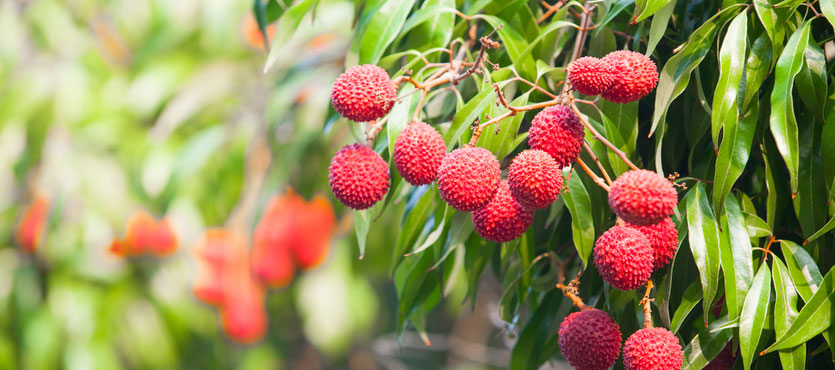Last month, our exploration started with a few of the best fruit trees for your South Florida garden, but there are so many great options, let’s finish the list! Remember South Florida is USDA Zone 10, the farthest south and the warmest of the hardiness zones in the United States. This semi-tropical environment allows you to successfully grow many tropical fruit trees that cannot be grown in most of the country. Let’s add to your list which already includes citrus trees, avocado trees, mango trees, and papayas.
Lychee Trees
Lychee Trees, also spelled Litchi, produce large clusters of red fruit, with a bumpy exterior which contains a sweet, juicy white flesh. The Lychee which is originally from southeast Asia grows very well in South Florida’s hot, humid climate. The Lychee tree is a large subtropical evergreen which produces fruit from late spring to late summer.
Lychee trees thrive when planted in fertile, well-draining, acidic soil. They should be planted in a protected area and pruned when needed, as mature trees, which can grow to 40 feet, have a dense canopy that is easily wind damaged. Lychee trees begin producing fruit in three to five years, which are harvested when red. Lychee fruit can be refrigerated for up to two weeks while you enjoy them.
Guava Trees
Guava Trees are another wonderful choice for your South Florida garden. You can choose Tropical Guava (the most common) or Strawberry Guava or both. Depending on the variety, Guava trees produce a red or yellow oval or pear-shaped fruit which are actually berries. Inside the rich, sweet flesh can be white, yellow, red, or pink.
Guava trees are a beautiful addition to your garden, not only for their delicious fruit, but also for their attractive appearance. The trees are small with short, wide canopies and mottled green bark and long serrated leaves. You should plant your Guava trees in well-drained soil in an area with plenty of room for the roots to spread. Guava trees begin to produce fruit in two to four years, presenting as much as 80 pounds of fruit annually. In South Florida, with the proper attention and pruning, your Guava tree may produce fruit year-round. Guava is picked with the color changes from green to light green or light green to yellow, depending on the variety. The picked fruit will then ripen at room temperature. When it is soft and smells sweet and musky, it is time to enjoy your harvest.
Sapote Trees
Sapote trees, while lesser known, grows well in South Florida and produces delicious fruit. Sapote trees are large subtropical evergreens native to Central America and can reach heights near 65 feet. The Sapote is a member of the Persimmon family and produces oval-shaped fruit with sweet juicy flesh which has been described as cross between a peach and a banana. Sapote trees are prolific and produce abundant fruit annually.
You should plant your Sapote tree in a warm, sunny location, sheltered from the wind in rich, well-drained soil. If you plant more than one Sapote, they should be placed 25 feet apart. Fruit is harvested unripe when they are two to six inches in diameter and the skin has gone from shiny to dull. Harvest time varies but is typically December to February and June to August.
Now you have added three more wonderful fruit trees to your growing South Florida garden. Call on the expert team at Xtreme Landscaping when you are ready to get started, we’ll provide tips and all the help you need to get your fruit trees planted and growing toward a fruitful harvest right in your own backyard.
If you missed Part One of this article: CLICK HERE.

